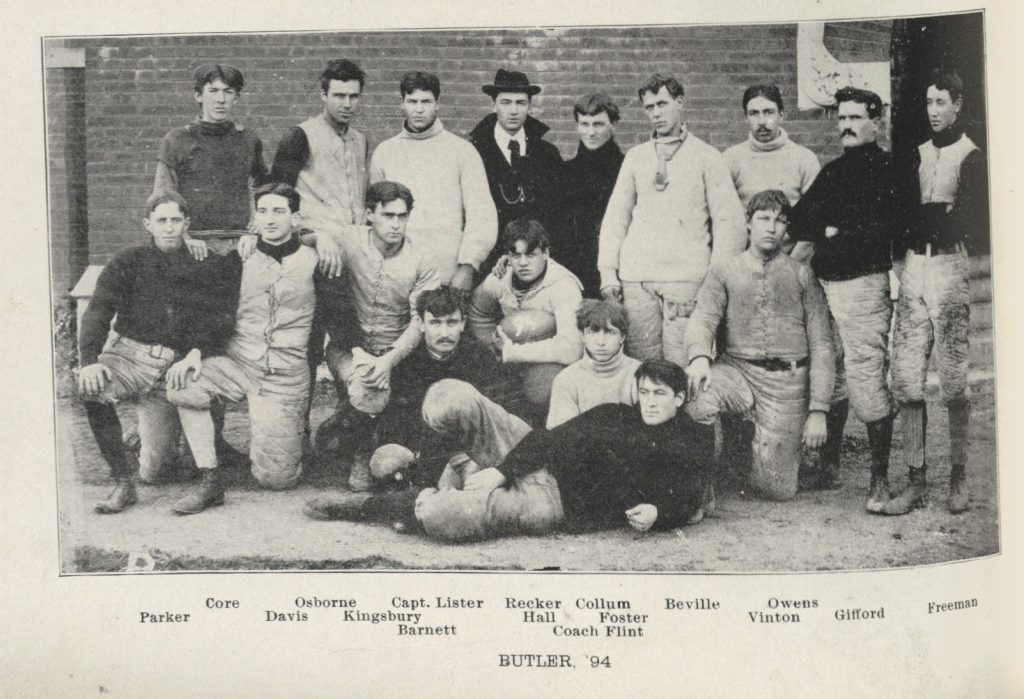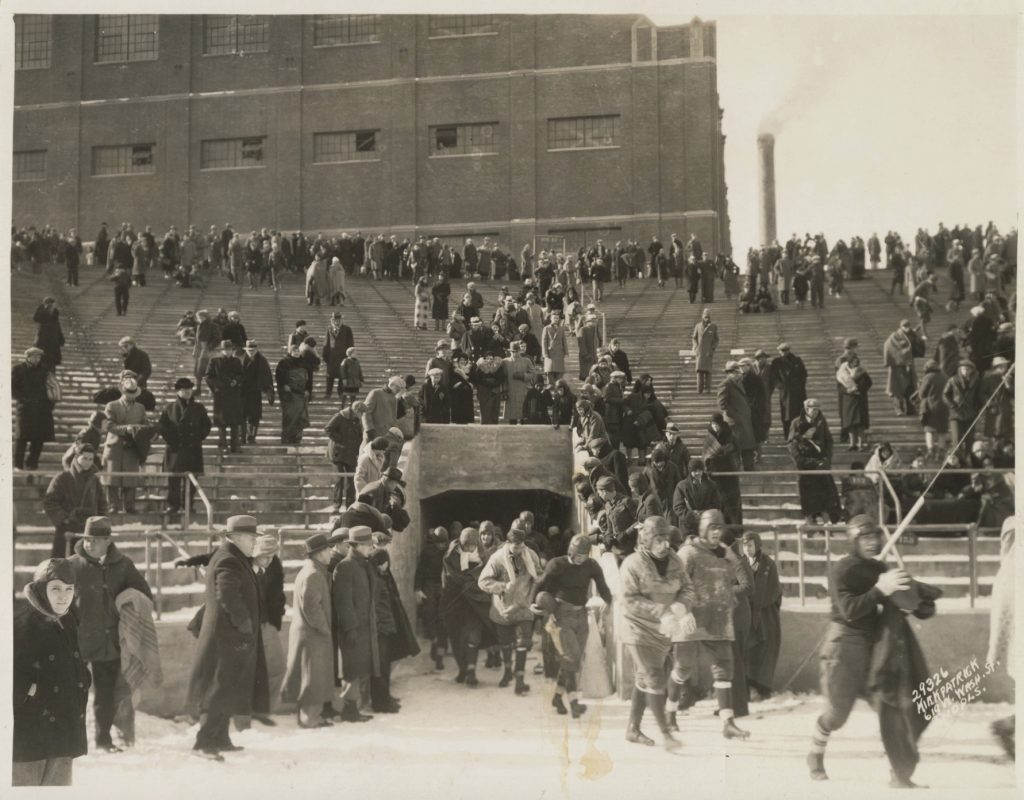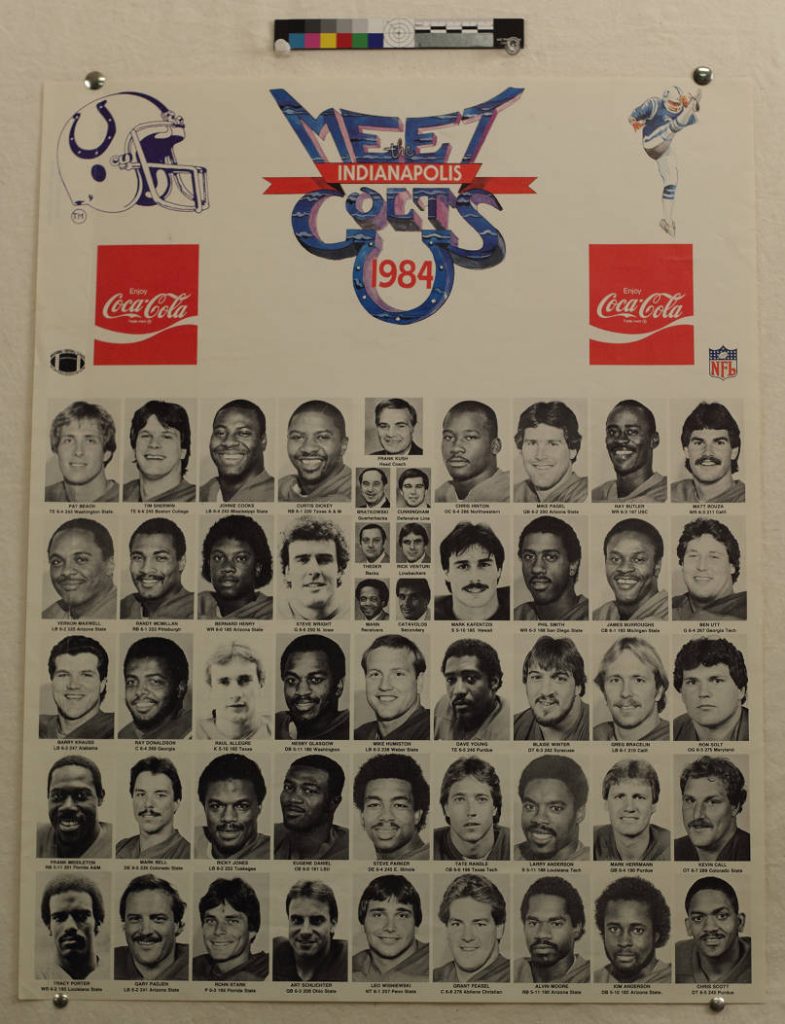College
Butler and DePauw played the state’s first intercollegiate game at the old 7th Street Baseball Grounds in Indianapolis in the spring of 1884. Butler senior John F. Stone compiled the rules for the game. He combined association (soccer) rules with eastern intercollegiate rules to form the western intercollegiate rules, which were published by Charles Mayer of Indianapolis. Butler won the game by a score of four goals to one.
Association rules dominated the intercollegiate games held in Indianapolis until 1886. In that year, four Ivy League graduates—Merrill Moores, Clinton Hare, Pirtle Harrod, and William Bradshaw—formed the Indianapolis Athletic Association (IAA) for the purpose of introducing rugby football in Indiana. The IAA sponsored all intercollegiate games, supplying players with train tickets for the games in Indianapolis. Butler, Hanover, Wabash, and Franklin colleges competed for the state championship with Wabash coming out on top. The IAA also sponsored games in 1887, but in 1888 the presidential campaign of native son absorbed everyone’s interest and no football games were played.

Games resumed in 1889 under the auspices of the newly formed Indianapolis Intercollegiate Athletic Association (IIAA). This group, composed of each institution’s president, guided college football through the 1890s. During that decade, numerous independent athletic club football teams developed throughout the state (two of Indianapolis’ more famous clubs were the Light Artillery Eleven and the Zig-Zag Club). Many top college teams dropped IIAA opponents to schedule games with these athletic clubs. This problem came to a head in 1894 when Butler scheduled a Thanksgiving Day game against the Indianapolis Light Artillery Eleven that clashed with the traditional Thanksgiving Day game between Purdue and DePauw at the State Fairgrounds. Bitter feelings over lost gate receipts nearly resulted in Butler’s expulsion from the IIAA.
The IIAA held an emergency meeting in Indianapolis in December 1894. The athletic club controversy, as well as a general outcry against the roughness of the game, led them to drop football until the rules were reformed. In 1895, the IIAA adopted new rules banning rough play and games against non-collegiate teams. It also called for officials with more stamina and authority to enforce these regulations.
Most Indiana colleges built their own football fields during the 1890s, and, during the first quarter of the 20th century, Butler was the only college team playing in the city. Indiana Central College began playing football at its southeast-side campus in 1924. Its program struggled for seven years before disbanding in 1932.

On October 13, 1928, Butler College played Franklin College in the first game at Butler Bowl. Originally planned as a 75,000-seat stadium, the Bowl as finished held only half that number. It lost another 16,000 seats to ‘ Hilton U. Brown Theater in 1955. By the 1990s, the stadium seated 18,000.
In 1971 Indianapolis became the site of the annual Top Dog game played on the last day of the season between the Butler University Bulldogs and the Greyhounds (formerly Indiana Central College, which reinstated football in 1945). The two schools’ alumni associations developed the trophy to focus attention on the intracity rivalry. For most of the Top Dog game’s history the schools have played in the same conference. However, in 1992 Butler joined another conference, marking the probable end of the series after the 1993 game.
High School
The first high school football games in Indianapolis were played between Indianapolis High School and Indianapolis Training High School, later known as Shortridge and Manual, in the late 1890s. However, neither school played a formal annual schedule until after the founding of the (IHSAA) in 1903.

In 1920 the newspapers began naming an unofficial city football champion based on won-loss records. Also, in that year Shortridge, Manual, and Tech began vying for the School Board Trophy. The award was to go to the first five-time undisputed city champion. By the time claimed it in 1935, Broad Ripple, Washington, and Cathedral had joined the citywide competition. By 1955 eight public schools and four parochial schools competed for the city championship. At this time there were plans to establish a formal city football league and abolish the traditional method of naming an unofficial champion, but scheduling conflicts prevented the plans from materializing.
By the 1990s the city’s seven public and five parochial high schools vied for the city championship that was voted on by the 12 head coaches at the end of the regular season. Since the establishment of the state high school football tournament in 1973, all Indianapolis high schools went on to compete for the state football championship in their respective classes under the auspices of the IHSAA.
Professional

Indianapolis has a long history of minor league professional football. The city’s first professional team was the J. J. Cuming All-Stars, who played in a statewide league in the 1920s. In 1961 the Indianapolis Warriors played a ten-game schedule in the newly formed United Football League. They played their home games at the old Victory Field and hosted the UFL championship game in 1964. A year later, having lost money every year, the franchise moved to Fort Wayne. From 1968 to 1980, Indianapolis was home to a professional football team called the Capitals. The Capitals played in several different leagues and moved their home venue from to Indiana Central University’s Key Stadium during their 13-year history.
The city’s first venture into the National Football League came in 1933. In September of that year, the Indianapolis Football Indians played only three games, all lopsided losses, before management disbanded the team. In 1984 the Baltimore Colts became the , playing in the newly built (which has since been demolished and replaced by Lucas Oil Stadium), and Indianapolis has been an NFL city ever since.
*Note: This entry is from the original print edition of the Encyclopedia of Indianapolis (1994). We are currently seeking an individual with knowledge of this topic to update this entry.

Help improve this entry
Contribute information, offer corrections, suggest images.
You can also recommend new entries related to this topic.
